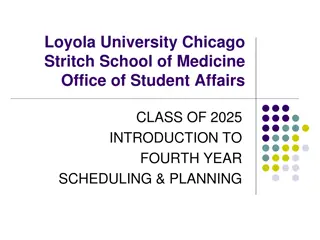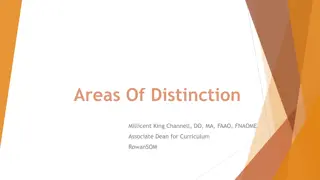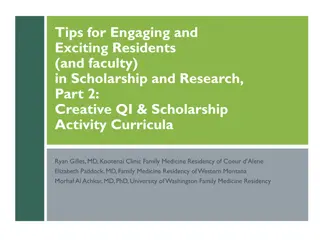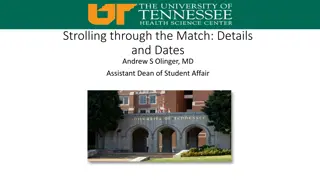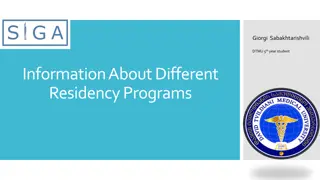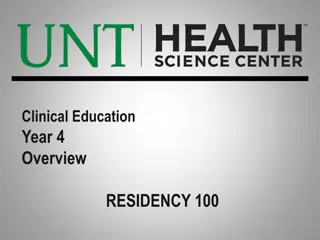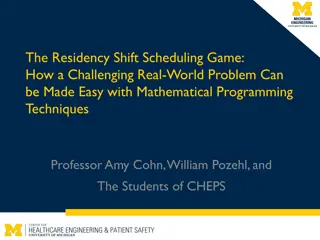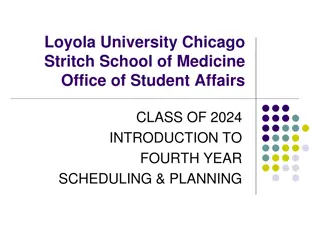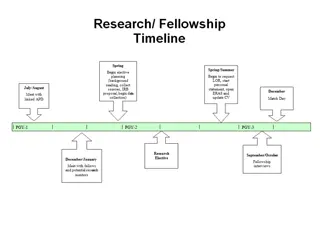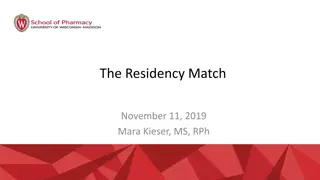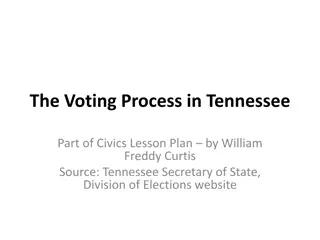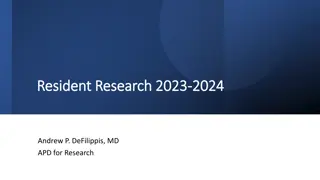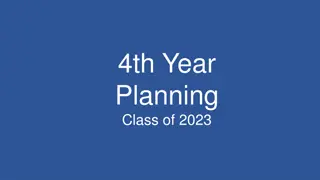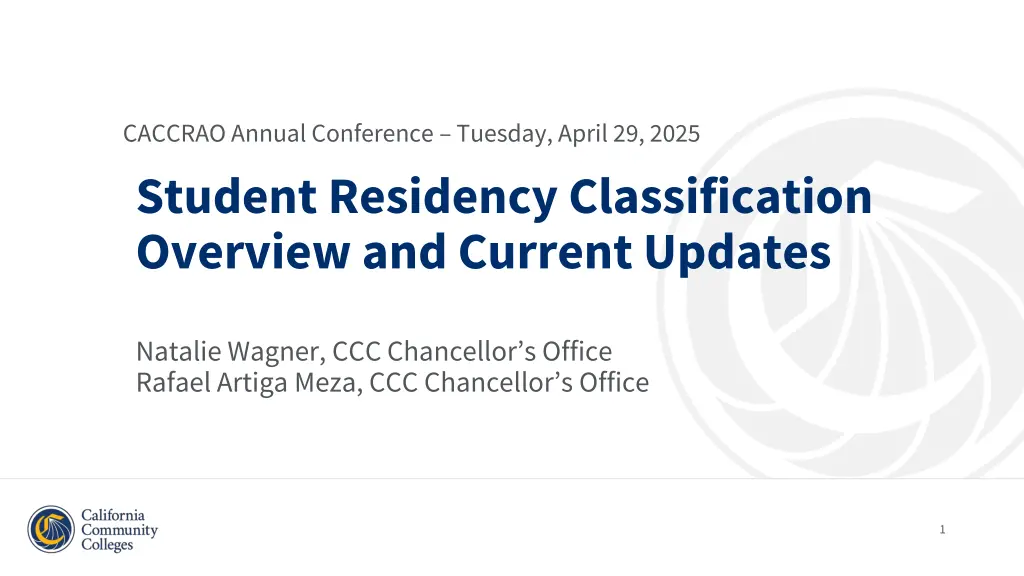
Student Residency Classification Overview and Updates
Understand the definitions and rules regarding student residency classification in California, including residency determination criteria, exceptions, and tuition payment regulations. Stay informed on the latest updates and pending legislation affecting student residency status.
Uploaded on | 0 Views
Download Presentation

Please find below an Image/Link to download the presentation.
The content on the website is provided AS IS for your information and personal use only. It may not be sold, licensed, or shared on other websites without obtaining consent from the author. If you encounter any issues during the download, it is possible that the publisher has removed the file from their server.
You are allowed to download the files provided on this website for personal or commercial use, subject to the condition that they are used lawfully. All files are the property of their respective owners.
The content on the website is provided AS IS for your information and personal use only. It may not be sold, licensed, or shared on other websites without obtaining consent from the author.
E N D
Presentation Transcript
CACCRAO Annual Conference Tuesday, April 29, 2025 Student Residency Classification Overview and Current Updates Natalie Wagner, CCC Chancellor s Office Rafael Artiga Meza, CCC Chancellor s Office 1
Agenda Basic Residency Definitions Primary Purposes for Residence Classification General Rules and Guidelines Updates, Reminders, and Pending Legislation Residency Quiz Questions/Comments Update on Student Residency Classification
Basic Residency Definitions Resident (For tuition purposes): Unless precluded, a resident is a student who has been physically present in the state for more than one year immediately preceding the residence determination date (one year and one day), and has demonstrated an intent to make California a permanent home. EC 68017 A nonresident is a student who does not have residence in the state for more than one year immediately preceding the residence determination date. EC 68018 Nonresident 3
Basic Residency Definitions Residence: To establish or change a residence, a person capable of establishing residence must couple his or her physical presence with objective evidence that the physical presence is with intent to make California the home for other than a temporary purpose. EC 68062(d); Note: Physical presence alone is insufficient; intent alone is insufficient Residence Determination Date: Residence determination date is the day immediately preceding the opening day of instruction of the quarter, semester, or other session as set by the district governing board, during which the student proposes to attend a college. Enrollments in late starting classes within a term are subject to this uniform residence determination date.
Basic Residency Definitions Exceptions to Residence Determination: Education Code prescribes several exceptions to residence determination some are required (e.g. military members stationed in CA ECS 68075) and some are permitted (e.g. individuals hired as a peace officer by public agency ECS 76140.5) These apply where an individual that is NOT otherwise eligible to be classified as a Resident for tuition purposes, can nonetheless be classified as a Resident and claimed for apportionment purposes if applicable requirements are met Exceptions to Payment of Nonresident Tuition: Education Code also prescribes situations where the nonresident tuition is either required to be exempted (e.g., AB 540, AB 2364) or a district is given permission to exempt specified students (e.g., non resident students who take six or fewer units 76140(a)(1)) In some cases apportionment can be claimed for exempted student (e.g., AB 540, AB 2364) and in others apportionment is NOT claimable (e.g., non resident students who take six or fewer units 76140(a)(1) )
Proper charging of Nonresident Tuition (Note: Nonresident students must also be charged the basic enrollment fee) Primary Purposes for Proper claiming of State general apportionment Nonresident FTES is not included in state apportionment calculations (Note: certain nonresident students qualify to be reported as residents for apportionment purposes, such as AB 540 students or active military members stationed or domiciled in California) Next Steps for Implementation Residence Classification Student Eligibility for certain programs (Example: CA Promise Grant, formerly known as the BOG fee waiver)
General Rules and Guidelines Residence Classification: Residency classification shall be made for each student, except noncredit only enrollees, at the time applications for admission are accepted and whenever a student has not been in attendance for more than one semester or quarter (two, not one, semester or quarter of non-attendance). T5 54010(a) Timely student notification of the classification (within 14 calendar days) T5 54060(a) District must establish procedures for appeals of residency classification and refunds of nonresident tuition fees. T5 54060(b); 54070
General Rules and Guidelines Rules For Determining Residence There can only be one residence (an established primary and permanent home). EC 68062(a) A residence is the place when one remains when not called elsewhere for labor or other temporary purpose and to which he or she returns in seasons of repose. EC 68062(b) A residence cannot be lost until another is gained. EC 68062(c)
General Rules and Guidelines Rules For Determining Residence (Cont.) The one-year residence period necessary to be classified as a resident does not begin until the student both is present and has manifested clear intent to become a California resident. EC 68062(d); T5 54020 If a student or the parents of a minor relinquish California residence after moving from the state, one full year of physical presence coupled with intent is required to reestablish residence. T5 54030 Temporary absences will not result in a loss of California residence if, during the absence, the person always intended to return and did nothing inconsistent with that intent. T5 54022(b)
General Rules and Guidelines Rules For Determining Residence (Cont.) A person s residence shall not be derived from that of his or her spouse. EC 68062(e) The residence of the parent with whom an unmarried minor child resides is the residence of the unmarried minor child. When the minor lives with neither parent, his or her residence is that of the parent with whom he or she last resided. EC 68062(f) Moving to California primarily to attend school does not constitute establishing California residence, regardless of the length of that presence. T5 54022(c)
General Rules and Guidelines Residency Reclassification and Financial Independence: Financial independence status must be included as one of the factors in residency reclassifications EC 68044; T5 54032 EC 68044 focuses on parental support aspects, but also permits district governing boards to define other factors which may be considered in making residency reclassifications, such as support from family members other than the parent(s)
General Rules and Guidelines Residency Reclassification and Financial Independence (cont.): In determining intent, financial independence weighs in favor of California residence and financial dependence shall weigh against finding California residence Financial dependence in the current or preceding calendar year shall be overcome only if 1. the parent on whom the student is dependent is a California resident, or 2. there is no evidence of the student s continuing residence in another state T5 54032(d) permits a district to disregard a finding of financial dependence where there is not intent to establish (or maintain) residence elsewhere.
Updates, Reminders, and Pending Legislation
Memo: FS 24-06 Accepting Residency Determination from Another Community College District Education Code section 68101 allows a community college district to accept a student s residency determination from another community college district This memo provides guidance on ECS 68101 and outlines the process that districts should follow in accepting a student s residence determination made by another district Community college districts should develop local policies, which state whether they accept residency classification as determined by another community college district and any requirements or conditions that must be met. For any students for whom residency classification is accepted from another community college district pursuant to ECS 68101, the teaching college will not be subject to any audit finding related to residency classification as long as they have documentation on file from the community college district that made the initial classification stating that the student was classified as a resident in the current fiscal year. 14
Process To Be Followed In Accepting Residency Classification Pursuant to ECS 68101 College Requirements The teaching college should establish a local district policy for accepting residency classification as determined by another community college district. The teaching college must maintain documentation for audit purposes, for any students for whom residency classification is accepted from another community college district. This documentation should be issued by the college that performed the formal residency classification. In the event that information conflicts with a finding of California residence, the teaching college reserves the right to reject the residency classification from the community college district that made the initial classification. 15
Process To Be Followed In Accepting Residency Classification Pursuant to ECS 68101 Student Requirements Student must be currently enrolled at a California Community College with a formal residency classification made. Student must meet all admission and eligibility requirements at the teaching college. Student must provide documentation showing their formal residency classification issued by the current college the student is attending. This documentation should show that the student is classified as a resident in the current academic year. 16
Revoked Student Visas Recently, a number of student visas have been revoked Related to residency, districts are only required to classify a student as a resident or nonresident at the time applications for admission are accepted and whenever a student has not been in attendance for more than one semester or quarter (T5 58010) As long as the student remains enrolled, there is no requirement that districts review residency classification for these students in the middle of the term There is no requirement to drop these students as a result of the visa being revoked 17
6. In order to be classified as a resident, what steps must be taken by a noncitizen who is holding one of the visas or immigration status listed above, is out- of-status or is undocumented? He or she must present evidence (usually from USCIS), documenting that he or she has taken appropriate steps to obtain a change of status to a classification which does not preclude establishing domicile through one of the following actions: Applying for one of the following: permanent resident status, asylum, refugee status*, Family Unity Program, Temporary Protected Status, VAWA Self-Petition, withholding of removal Applying for and being granted a change of status to a visa category that permits establishing domicile Applying for and being granted Deferred Action for Childhood Arrivals (DACA) status Changing from Nonresident to Resident 18
EAD Cards and Residency Classification An EAD card is issued to noncitizens who have been granted temporary permission to work in the United States. It allows the recipient to remain and work in the United States but does not grant any other benefits and is not evidence of current immigration status. The EAD card includes immigration the category/code allowing the noncitizen to work in the United States, which corresponds to a status or visa type which may or may not be eligible to establish residency for tuition purposes. If the district is not able to readily determine whether the indicated immigration category/code can establish residence for tuition purposes, the admissions office should request further information from the student substantiating the person s status. 19
Moving to Live with California Resident Parent After Turning 18 37. If a student lives with one parent out of state and graduates high school in that state and then moves to California to live with the other parent at age 18, does the student need to wait one year to establish residence on their own? Not necessarily. ECS 68076 grants one year of resident classification to the adult child, natural or adopted, of a California resident. This applies to individuals who have not been an adult resident of California for more than a year, meaning they are 18 but not yet 19. One of the purposes of this section is to allow a one-year exemption so that a student is able to go from living with one parent to living with the other without having to wait a year to establish residence. Reference: EC 68076 20
There are no exemptions to residency determination or nonresident tuition exemptions specifically for student athletes. Student athletes must meet the same residency requirements as non-athletes. In 2010, our office released FS 10-01 which summarized requirements and best practices related to out of state athletes and residence determination. Best Practices Identified: Educate coaches and athletic staff members of residency requirements and funding implications (including consequences of false reporting) Offer an orientation for coaches, athletic staff and prospective student athletes regarding residency and how it is determined Arrange for a non-coaching staff or faculty member to attend the initial team meeting to oversee completion of paperwork and/or inform students of residency requirements and consequences of false information. Residency and Athletics 21
Nonresident Tuition Exemption for Refugees Reminder: Education Code section 68075.6 grants an immediate Nonresident Tuition exemption to eligible Special Immigrant Visa (SIV) holders and refugee students. This exemption is granted for one year (the time it takes to establish residence). The statute cites refugees admitted under Section 1157 of Title 8 of the United States Code. Title 8 USC section 1157 is tied to section 207 of the Immigration and Nationality Act: Admission of Refugees If students refugee paperwork includes references to section 207, this also makes them eligible. The statute is intended to apply to refugees broadly, not a certain population of refugees. 22
Afghan and Ukrainian Parolees In 2021 the U.S. Department of Homeland Security granted certain Afghan individuals with humanitarian parole in response to their need for rapid evacuation and relocation under Operation Allies Refuge/Operation Allies Welcome. In 2022, there was a similar evacuation of citizens and foreign nationals of Ukraine under the Additional Ukraine Supplemental Appropriations Act, 2022 (AUSAA). These individuals were also granted humanitarian parole. Being paroled into the US is the most expedient way to get people out of a certain country or identified area during evacuations. Being granted parole means that this person has permission to enter the US before having applied or been approved for an actual status such as refugee or a visa. 23
Afghan and Ukrainian Parolees Education Code section 68075.6 grants a one-year exemption to Nonresident Tuition fees to refugees admitted under section 207 of the Immigration and Nationality Act (8 U.S.C. 1157) who settled in California upon entering the United States. Given their eligibility to apply for benefits available to refugees admitted under section 207 of the Immigration and Nationality Act (8 U.S.C. 1157), Afghan humanitarian parolees and Ukrainian parolees who settled in California upon entering the United States may be eligible for this one-year nonresident tuition exemption until March 31, 2023 (for Afghan Parolees), or September 30, 2023 (for Ukrainian Parolees) or the end of their parole term, whichever is later. CCCCO Legal Division is reviewing to determine if these individuals are eligible to establish residence for tuition purposes. 24
Nonresident Tuition Exemption for Students Enrolled in 6 or Fewer Units Reminder: Education Code section 76140(a)(1) allows community college districts to provide a nonresident tuition exemption to students taking 6 or fewer units. The language states Exemptions made pursuant to this paragraph shall not be made on an individual basis, meaning that either the exemption applies to all nonresident students who take 6 or fewer units or the district does not offer this exemption at all. Our office has been informed that a few colleges have approved nonresident tuition exemptions for students taking 6 or fewer units but allowing only certain students to qualify for the exemption rather than all nonresident students as the law requires. Our legal division reviewed and confirmed that the exemption may not be provided to only certain groups of students. 25
Proposed Nonresident Tuition Exemption AB 695 AB 695 (Fong) would exempt a community college student from paying nonresident tuition if the student has been involuntarily removed from the United States due to immigration enforcement actions, if the student: Was not paying nonresident tuition at the time of deportation Provides proof of deportation status, and Reenrolls in a community college online education program 26
Proposed Nonresident Tuition Exemption AB 1346 Pursuant to ECS 68074, dependents of active duty military members are entitled to residency classification for tuition purposes. AB 1346 (DeMaio) states that military dependents do not lose their residency classification under ECS 68074 even if the service member is transferred out of state or has retired from active duty, as long as the student remains continuously enrolled or is granted to reenrollment pursuant to ECS 66208. 27
Conditions for Claiming Apportionment
Apportionment Eligibility for Nonresident Students Apportionment Eligibility of Nonresident Students for Credit and Noncredit Coursework: Credit: The attendance hours of nonresident students shall not be counted for apportionment of state funds for enrollment in credit courses, except as permitted by statute, including pursuant to Education Code Sections 68017, 68122, 68074, 68075.6, 68075.7, 68130.5 (AB 540), 76140(j). Noncredit: The attendance of nonresident students may be counted for apportionment of state funds for enrollment in noncredit courses if they are living in California during the period of attendance. A former requirement that they have been lawfully admitted to the United States is no longer in effect 29
Apportionment for Tutoring AB 1187 (Irwin) AB 1187(Irwin, 2022) expands the type of noncredit courses eligible for state apportionment funds to include supervised tutoring for foundational skills and for degree-applicable and transfer-level courses. The intended outcome is for all courses in students English and mathematics sequences to be eligible for supervised tutoring and thereby enable more students to be successful in courses leading to degrees, certificates, and transfer in less time and reducing the number of units students accumulate in their academic journey. 30
Apportionment for Tutoring 84757 (a) For purposes of this chapter, the following noncredit courses, noncredit classes, and support services shall be eligible for funding: . . . (10) Supervised tutoring for foundational skills and for degree-applicable and transfer-level courses, as authorized pursuant to regulations adopted by the board of governors on or before July 31, 2023. These regulations shall ensure that community colleges are compliant with Section 78213 in the implementation of supervised tutoring pursuant to this paragraph. 31
Regulatory Changes: Tutoring In 2023, the CCCCO approved regulatory changes to align the regulations with the changes in statute. These changes are summarized in memo ESLEI 24-06 . Reminders: 1. A tutorial center may offer tutoring where the tutor and tutee are separated by distance and are using on-line or other synchronous real time technologies. When this method is used, the supervisor must be able to monitor the communication and accurately track positive attendance hours. 2. Districts may not claim apportionment for tutoring that is fully funded by another source such as categorical funds. 32
Regulatory Changes: Tutoring Summary of Regulatory Changes 58160: State Apportionment for Noncredit Courses, Noncredit Classes, and Support Services. Updated the exclusive list of noncredit courses that are eligible for state apportionment funding. 58168: Criteria for Supervised Tutoring. Clarified the coordination of Supervised Tutoring Clarified Supervision of faculty Clarified the role of Classified Staff 58170: Apportionment for Tutoring Section removed. Apportionment requirements moved to 58160. 53415: Minimum Qualifications for Learning Assistance Instructors Clarified the minimum qualifications 33
Special Admit FTES Limits Special Admit FTES Limits: 1. A district may only claim apportionment for up to 10% special admit students enrolled in a PE course, if they go over this amount the extra students must be excluded from the apportionment calculations. (Special admit students in a PE course/total students in the PE course < 10%) 2. A district may not claim apportionment for special admit students enrolled in PE courses in excess of 5% of the districts total special admit students. (Special Admit PE/total special admit FTES < 5%) 3. Statewide Cap: Special Admit FTES shall not be more than 10 percent of total FTES statewide. (76004(w)) 34
AB 540 Updates, Reminders and Commonly Asked Questions
AB 1540: AB 540 Affidavit from CSAC AB 1540 (Fong, 2023) amended Education Code section 68130.5 to require that community colleges accept a student s AB 540 affidavit from the California Student Aid Commission (CSAC) that is completed as part of the student s California Dream Act financial aid application. CSAC is responsible for sending the completed affidavit to all colleges listed on the student s California Dream Act application. Once the affidavit is received from CSAC, the college should have a process in place to share the affidavit with all relevant departments within the college. CSAC is not responsible for determining student eligibility for the AB540 nonresident tuition exemption or for verifying the information on the affidavit. Colleges may take steps to determine a student s eligibility including verifying the information provided in the affidavit 36
Must AB 540 students reside in California? In order to be eligible for AB 540, a student must meet the requirements related to attendance and completion of a course of study in California. Our office has been getting questions about whether an AB 540 eligible student remains eligible if they move out of state and attend online Our prior legal guidance 07-01 states the exemption is not available for students who are absent from California taking online courses Legal is reviewing now, initially said students do not need to reside in California, then talked with UC and said they do need to reside in California For now, our guidance remains as is, AB 540 nonresident tuition exemption is not available for students who live outside of California and take online courses only. 37
Current AB 540 Exemption Eligibility Criteria Requirement 1: Attendance at California schools Two Paths: Total attendance (or attainment of credits earned) in California equivalent to three or more years of full-time attendance at California high schools, California high schools established by the State Board of Education, California adult schools (established by a county office of education, a unified school district or high school district, or the Department of Corrections and Rehabilitation), campuses of the California Community Colleges, or a combination of these; or Three or more years of full-time high school coursework in California, and a total of three or more years of attendance in California elementary schools, California secondary schools, or a combination of California elementary and secondary schools.
Current AB 540 Exemption Eligibility Criteria Requirement 2: Completion of a course of study This requirement may be met in any of the following ways: Graduation from a California high school or equivalent. Attainment of an associate degree from a California community college. Fulfillment of the minimum transfer requirements established for the University of California or the California State University for students transferring from a California community college. (Ed. Code, 68130.5, subd. (a)(2).)
Current AB 540 Exemption Eligibility Criteria Requirement 3: Registration. Requires registration as an entering student at, or current enrollment at, an accredited institution of higher education in California. Requirement 4: Affidavit of student without lawful immigration status. Students without lawful immigration status must file an affidavit with their college or university stating that the student has either filed an application to legalize his or her immigration status, or will file an application as soon as he or she is eligible to do so. (Note: All students seeking the AB 540 exemption must complete the affidavit.)
Commonly asked questions Question: Can colleges accept partial Community College attendance in an academic year? Answer: Yes. The accumulation of credit and/or non-credit courses in any academic year shall be calculated in reference to a year s equivalence, and not the amount of credit or non- credit earned per semester or per quarter. Full-time Attendance Measures 1-Year Equivalent 3-Year Equivalent High School 55 credits 165 credits Adult School 420 class hours 1260 class hours 72 credit units (used to be a 2-year cap) Community College (Credit) 24 credit units Community College (Noncredit) 420 class hours 1260 class hours
Commonly asked questions Question: Does the attendance requirement have to be completed before the completion of a course of study requirement? Example: Student who has 2 years at a California high school and graduated with a high school diploma. After graduating, she attended noncredit community college classes and completed 450 class hours. Answer: No. There is no specific sequence outlined in the statute, as long as the student meets all applicable requirements, they would be eligible for the exemption.
Commonly asked questions Question: Are students who are out of status or undocumented eligible for this exemption? Answer: Yes. Students who previously held valid nonimmigrant visas but who are out-of-status, or those who are undocumented at the time of execution of the affidavit are eligible for the AB 540 exemption.
Commonly asked questions Question: Does a student s visa have to be expired for the student to be considered out of status ? Answer: Not necessarily, if a student overstays his/her I-94 authorization date, the student is in violation of the terms of that visa and would be considered to be out of status even if the visa is not expired.
Commonly asked questions Question: What if a student does not know how many credit hours from elementary, middle, and high school they completed? Answer: In this case, the best approach would be to rely upon periods of attendance. For community college purposes, self- certification of attendance is sufficient. UC or CSU may require more.
Commonly asked questions Question: Are students required to submit supporting documentation such as transcripts to show they meet the requirement for attendance at California schools? Answer: The statute requires only that the student file the AB 540 affidavit. The Chancellor s Office does not require the college to collect supporting documentation beyond the completed affidavit (self-certification form). Colleges may accept self-certification on its own with the student s signature, or may require supporting documentation.
B-visas and AB 540 Eligibility Question: Is an out-of-status B-visa student eligible for AB 540? Answer: Yes. Legal Advisory 18-02, page 8 states: Students who previously held valid nonimmigrant visas but who are out-of-status at the time of execution of the affidavit are eligible for the exemption. Question: When do they become eligible? Answer: The CCCCO Legal Division has always taken the position that if the student overstays his/her I-94 authorization date, the student is in violation of the terms of that visa and would be considered to be out of status even if the passport is not expired.
B-visas and AB 540 Eligibility Question: Are community colleges allowed to admit students holding a B-visa? Answer: Individuals with a B-1 or B-2 visa are prohibited from enrolling in a course of study. However, the prohibition is on the visa holder, not the college (there is nothing in the law that says colleges may not enroll B-visa holders). The CCCCO Legal Division has not issued an opinion on this matter, instead, they defer to college s legal counsel to set a policy of enrolling or not enrolling B-visa holders.
Resources and Ways to Stay Informed Residency Overview Document Student Attendance Accounting Manual Chancellor s Office Monthly Fiscal & Policy Webinars 49



